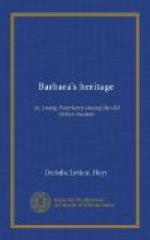“Here on this side,” pointing at a large fresco which covered the entire wall, “is La Disputa, or Theology. Above, on the ceiling, you see a symbolic figure representing Religion, with the Bible in one hand and pointing down at the great picture with the other. Opposite is the School of Athens. Above this is a figure emblematic of Philosophy, wearing a diadem and holding two books. On the two end walls, broken, as you see, by the windows, are Parnassus, peopled with Apollo and the Muses, together with figures of celebrated poets,—above which is the crowned figure with a lyre which represents Poetry,—and,” turning, “the Administration of Law, with ceiling-figure with crown, sword, and balance, symbolizing Justice. In this room the painter had much to contend against. These opposite windows at the ends, which fill the space with cross-lights, and around which he must place two of his pictures, must have been discouraging. But the compositions are consummately fine, and the whole is so admirably managed that one does not even think of that which, if the work were less magnificent, would be harassing.
“I advise you to come here early some morning and bring with you some full description of the pictures, which tells whom the figures are intended to represent. Study first each painting as a whole; see the fine distribution of masses; the general arrangement; the symmetry of groups which balance each other; the harmony of line and color. Then study individual figures for form, attitude, and expression. I think you will wish to give several mornings to this one room.
“What do you think of this, Malcom? Do you not wish to get acquainted with Plato, Aristotle, Cicero, and Virgil?” added Mr. Sumner, putting his hand suddenly on the young man’s shoulder, and looking into his face to surprise his thought.
“I think it is fine, Uncle Rob. It’s all right;” and Malcom’s steady blue eyes emphasized his satisfaction.
“What do you call Raphael’s greatest picture?” asked Barbara, as they turned from the frescoed walls.
“These are his most important frescoes,” replied Mr. Sumner; “and all critics agree that his most famous easel picture is the Madonna di San Sisto in the Dresden Gallery. This is so very familiar to you that it needs no explanation. It was, you know, his last Madonna, and it contains a hint of Divinity in both mother and child never attained by any painter before or since.”
“When shall we see Raphael’s tapestries?” asked Margery, as they finally passed on through halls and corridors.
“I hardly think I will go with you to see those, Madge dear,” answered her uncle. “There is no further need that I explain any of Raphael’s work to you. Your books and your own critical tastes, which are pretty well formed by this time, will be quite sufficient. Indeed,” looking around until he caught Barbara’s eyes, “I really think you can study all the remaining paintings in Rome by yourselves,” and he was made happy by seeing the swift regret which clouded them.




